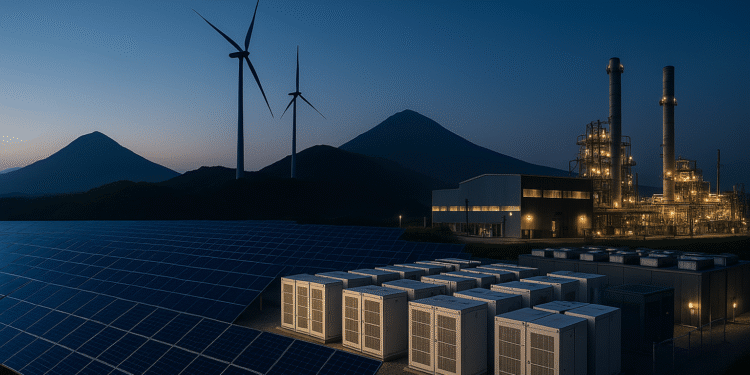In 2025, grid-scale battery storage is at the forefront of the energy transformation. For entrepreneurs eyeing greenfield land development—turning untouched land into renewable energy projects—large-scale battery energy storage systems (BESS) offer lucrative opportunities. Whether standalone or hybrid with solar, wind, or even powered by innovations from companies like Shell, these systems support the grid and generate substantial revenue. This guide explores how to monetize BESS, shares tales of entrepreneurial success, and provides actionable insights for aspiring developers.
The Basics of Grid-Scale Battery Storage
Grid-scale BESS are massive installations that store electricity from the grid or renewables, releasing it when needed. They range from tens to hundreds of megawatts, often housed in container-like units on vast plots of land. These systems address the intermittency of solar and wind power, ensuring stable energy supply and reducing reliance on fossil fuels.
Why is this booming? Global deployments surged in 2025, with additions like 4.9GW in the US in one quarter alone. For entrepreneurs, this means untapped potential in developing these on greenfield sites—undeveloped land ideal for large footprints without urban constraints.
Key Revenue Streams for BESS Projects
Making money with BESS involves multiple streams, often “stacked” for maximum profitability.
- Energy Arbitrage: Buy electricity cheap during off-peak hours (e.g., 2-5 AM) and sell high during peaks. This can account for 20-60% of revenues. In CAISO, 72% of 2024 revenues came from this.
- Ancillary Services: Provide grid stability through frequency regulation, voltage support, and reserves. Batteries respond quickly, earning premiums.
- Capacity Markets: Guarantee availability during high demand, receiving payments for readiness.
- Demand Response and Behind-the-Meter Savings: For hybrid setups, reduce costs for on-site users or earn from market participation.
- Emerging Streams: New opportunities like virtual power plants or AI-optimized trading are emerging in 2025.
Advanced controllers can payback investments in years. A coalition pledged $100B in US manufacturing, signaling growth.
Opportunities in Greenfield Land Development
Greenfield sites—pristine, undeveloped land—are perfect for BESS due to space, lower costs, and fewer regulations than brownfields. Entrepreneurs can acquire land cheaply, secure grid connections, and develop projects from scratch.
Steps for development:
- Site Selection: Look for proximity to substations, renewables, and high-demand areas. Tools like GIS mapping help.
- Permitting and Planning: Navigate local approvals; e.g., RPC and Greenfield secured 500MW in UK.
- Financing: Use tax credits, grants; projects like Beehive (250MW) show viability.
- Construction: Partner with firms like Cypress Creek for end-to-end development.
Challenges include community opposition over fire risks, but proper safety mitigates this.
Hybrid Energy Systems: Combining BESS with Renewables
Hybrid setups integrate BESS with solar/wind for enhanced efficiency. Store excess renewable energy and dispatch optimally.
Benefits:
- Higher revenues from combined arbitrage and incentives.
- Grid resilience; e.g., solar + storage bundles.
- Lower LCOE (levelized cost of energy).
In 2025, hybrids are key for entrepreneurs, turning greenfields into energy hubs.
Inspiring Tales: Entrepreneur Success Stories
- Sepion Technologies: Founded in 2015 from LBNL research, commercialized advanced membranes for EV/grid batteries, raising funds and scaling.
- Cypress Creek Renewables: Mission-driven, develops solar + storage from greenfield, creating jobs and clean energy.
- Anesco Partnership: UK entrepreneurs partnered with Shell for utility-scale BESS, entering markets profitably.
- Gridcog Case: Behind-the-meter BESS for C&I, earning from markets and savings.
These tales show persistence pays; start small, scale with partnerships.
Shell’s Role in Powered Hybrid Battery Storage
Shell is pivoting to renewables, committing $1.5B to storage by 2025. Key projects:
- 500MW/1000MWh BESS in Australia with Greenspot.
- Immersion-cooled system in China with QAES.
- UK entry via Anesco.
Shell’s AI-powered strategies enhance hybrid efficiency, offering models for entrepreneurs.
Practical Steps to Launch Your BESS Venture
- Research Markets: Analyze regions like Texas, California for high arbitrage.
- Secure Land and Grid Access: Target greenfields near infrastructure.
- Build a Team: Include engineers, financiers; learn from developers like Field Energy.
- Finance and Build: Use models from EY for investment guidance.
- Operate and Optimize: Employ EMS for revenue stacking.
Overcoming Challenges in BESS Development
- Regulatory Hurdles: Vary by location; engage early.
- Costs: Falling battery prices help; stack revenues.
- Safety Concerns: Use advanced tech to prevent fires.
- Market Volatility: Diversify streams.
Solutions include partnerships and insurance.
The Future of Battery Storage Investments
By 2035, growth at 14.7% CAGR; new tech like immersion cooling from Shell. Entrepreneurs can lead in sustainable wealth creation.
Partnering for Success
Ready to dive in? Reach out to phil@pacificoenergy.com for expert BESS solutions. Pacificoenergy.com specializes in commercial projects, like their 6.5MW system in Bernardston, USA.
At positivephil.com, we believe in positive action for a greener planet. Let’s build profitable, sustainable futures!
Stay positive, stay charged, and power your dreams with clean energy!


















